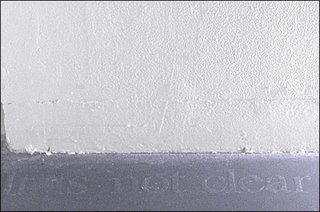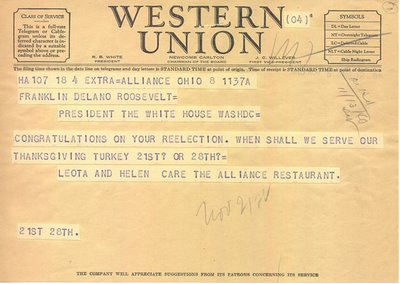Wednesday, November 29, 2006
Cool. Get a little more of a tax refund this year.
Snopes.com :: 2006 Federal Excise Tax Credit
(Thanks, Found on the Web!)
I'd like every one of these books.
This one really intrigued me though.
Kessels and Stultiens ... found a remarkable series of photographs taken by a taxi driver of one passenger only. The passenger and the taxi are pictured in front of mountains, fields, sunsets, city squares, highway rest stops. What were they doing there? Who was she? Why did she travel like this?"



In Almost Every Picture 2
Charles Gute :: On Savantism
On the gallery floor near the base of the wall, running the entire perimeter of the space, was a text rendered in hand-cut translucent adhesive vinyl. Although scarcely visible, the text, appropriated from psychology journal, offered a kind of tacit commentary on both the student works hung directly above throughout the gallery, and on the manner of fabrication of the work itself.


Full text:
It is not clear who qualifies as a savant, nor is it easy to tell the difference
between a mentally retarded savant and an autistic savant, though there are
some distinguishing features. IQ is one. Retarded savants generally have an IQ
of 50 to 70 while some autistic savants have IQs of 140 and above. Another
difference is that autistic savants often go on to successful careers as
artists and mathematics teachers, for example, while retarded savants rarely
find jobs related to their skills.
The two groups also respond differently to institutionalization. The mentally retarded savant is apt to do well in a special school, often developing even greater
savant talents there. The autistic savant, however, frequently loses his
special abilities when he is forced to attend an institution.
T-Equalizer - the shirt that throbs.
Rendering every other 'look at me' T-shirt utterly obsolete, the T-Equalizer is the ultimate in clubwear. Forget about sweary shock Ts and retro schlock Ts, this eye-catching shirt is guaranteed to mesmerize fellow clubbers and pubbers as it illuminates and moves in time to the music.

Firebox :: T-Equalizer
Monday, November 27, 2006
AllPosters.com - 35% off


AllPosters.com :: Vintage Posters
IMPORTANT:
To get the discount, enter Allposters.com through this page. (According to Dealtaker.com, "a portion of all money earned from your use of the promotional codes and coupons goes to help the fight against breast cancer." Cool.)
Xing Qing
Xing (“natural tendencies”) and qing (“feelings” or “affectivity”) are two key terms in Zhongyong. The Chinese character xing and qing both contain one element: xin. So here’s where my attempt to explain the meaning of the two terms begins.
Xin, which is generally translated as “heart”, actually has a broad meaning. Almost all Chinese characters related to “feelings” has the element “xin” as a constituent part. It’s because like the ancient Egyptians, the ancient Chinese held that heart is the biological component for thinking and feeling, which are now recognized as the functions of the mind. So looking at the Chinese characters, you could find that xin means both thinking and feeling.
Now let’s take a look at the character xing. It has two parts, xin (thinking and feeling) and sheng (born). In many translations of Chinese classics, the word xing means nature, something people are born with. Is this a felicitous translation? This is the first question this article attempts to answer.
Xing is Natural Tendency
Zhongyong begins with “what tian commands is called natural tendencies”. (天命之谓性).
Because of Zhongyong’s particular role in Chinese philosophy, a bridge connecting the Confucianism and Daoism, understanding these two terms requires a careful reading of all of the Confucian and Daoist classics. In explaining this sentence, I first sought answer from the Analects. Zigong said, “We can learn from the Master’s cultural refinements, but do not hear him discourse on subjects such as our ‘natural disposition (xing)’ and ‘the way of tian (tiandao)’”1. According to my understanding, the reason why Confucius doesn’t talk about xing or tian is not because they are not important terms, but quite the contrary, they are so important that Confucius thinks you cannot simply put it into words and teach others; a better way would be for the others to spontaneously seek it through observing the conducts of exemplary persons and thus learn about it.
In Zhuxi’s commentary of the Zhongyong, xing is defined as li (rationality), xing ji li. However, the Chinese li is different from the Platoic reasoning or Aristotelian rationality. Li is closely related to people’s relationship with the world and their feelings toward the world.
When Aristotle discusses virtues, he tends to attribute it to acting upon rational principle, not something that comes to us by nature, for the function of human beings is “an activity of soul which follows or implies rational principle”2. In the Confucian tradition, on the other hand, virtues come from natural tendencies.
Mencius, as opposed to Confucius, doesn’t only talk about xing, but also gives a metaphorical explanation on the relationship between human nature and human goodness: “The tendency of man's nature to good is like the tendency of water to flow downwards. There are none but have this tendency to good, just as all water flows downwards.”3 This passage gives us the idea that “natural tendency”, not nature, is the matter that concerns most, for if human nature is virtuous, where does the need of nurture and development come in? This reminds me of the “ought” implies “can” principle in Kantian philosophy. I think the Kantian “ought” implies virtues, and “can” implies a possibility. “Natural tendency” suggests man’s possibility of being virtuous.
Look further in the Works of Mencius, says: “The feeling of commiseration is the beginning of ren; the feeling of shame and dislike is the beginning of rightness; the feeling of deference and compliance is the beginning of propriety, and the feeling of right and wrong is the beginning of wisdom. Men have these four beginnings just like they have their four limbs. ”4 Hence, we could see that like a bud needs water and sunshine to grow, human being have the natural tendency to be virtuous but are not naturally virtuous, so it also needs nurturing and educating. In this case, simply translating xing as “nature” is partial. A felicitous translation of xing would be “natural tendency”.
Xing serves “at least three functions: explanatory, originative, and regulative. In other words, “xing” rationally explains the moral motivation of a person in whatever sense of morality commands and compels our general and basic respect and trust; “xing” is understood or experiences to originate our initial moral impulses, which lead to our moral behaviors; and “xing” finally provides a normative or prescriptive definition of goodness: whatever “xing” manifests under optimum natural conditions is ontologically good and therefore should provide a basis and a starting point for moral goodness.”5
Another point calls for attention is the nontranscendent and organismic concept in early Chinese cosmology. The natural tendency of human beings is not endowed, but commanded, which means xing is not only generic, but also spontaneous. Xing is not an origin or an end, rather a process that requires human beings to put in their efforts.
Xing is a Process
Unlike the Western tradition in which tian is considered transcendent, the early Chinese tradition, since Zhou dynasty, bears the idea of san cai (ie. Tian (heaven), di (earth), and ren (human)) and pei tian (the complement of tian). The very basis of Zhongyong is the notion of tianrenheyi (heaven and human as one).
The process of self-realization, or self-transformation, which is later known as "learning to be a Sage" in the Confucian tradition was based on two premises: the Heaven-commanded natural tendency human possesses, and human’s capability of functioning as a creative agent. Therefore, it is “within one’s capacity in realizing and fulfilling this ideal goal of life.”6
Mencius said, “He who has exhausted all his mental constitution knows his nature. Knowing his nature, he knows Heaven. To preserve one's mental constitution, and nourish one's nature, is the way to serve Heaven.”7
To know the nature and nourish the nature is perceived as a way to serve heaven. This notion places one’s natural tendency in a position of a road map, which leads one closer to the way of tian. And since it “has its ultimate appeal to tian”, the natural tendency plays a role of “providing an authoritarian justification of the good.”8
“Exemplary persons cannot but cultivate their persons. In cultivating their persons, they cannot but serve their kin. In serving their kin, they cannot but realize human conduct. And in realizing human conduct, they cannot but realize tian.”9 This passage suggests that the start of being an exemplary person is realizing tian, which, as far as I’m concerned, means to realizing our natural tendencies, knowing that we are given the ability to think and feel. The second step, realizing human conduct, is about carrying out our natural tendencies, actualizing them in our conduct. The next requirement, serving the kin, shows an extraordinary character of Chinese culture, which is the emphasis on filial piety. And this is where it differs most from Western ideology. Chinese philosophy put more emphasis on people’s emotional experiences and relationships with others. Then a person could be said as a cultivated person. So everything boils down to what we are given. Here I want to stress that xing is generic; it’s given to everyone, which means everyone has the capacity to become an exemplary person. Yet we are all “given to be not totally determined by what are given, for we are given what is not presently realized in the given.”10
So the question is what is realizing the given. And here is
Where Qing Comes In
Commiseration with the suffering of others, shame at one's own faults, deference to superiors, and approval/disapproval of the actions of others (Mencius 2A.2) are all parts of human feelings, which is, as I understand it, the forms of natural tendencies (xing). While there is nothing good or bad about certain feelings, there is, however, differences in the appropriateness in expressing feelings.
“The moment at which joy and anger, grief and pleasure, have yet to arise is called a nascent equilibrium (zhong); once the emotions have arisen, that they are all brought into proper focus (zhong) is called harmony (he).”11
The Confucian tradition is more concerned with appropriateness than righteousness. So what matters most is the proper expression of qing, as it plays an important role in ritual propriety (li). Yucong (《语丛》) tells us that feelings rise from natural tendencies, and ritual proprieties rise from feelings ( 情生于性,礼生于情) ; it also says ritual proprieties are something people do according to their feelings (礼因人之情而为之) . Liji (《礼记》) expresses similar idea by saying “teaching the people to love one another, and high and low to cultivate good feeling between them;--such was the effect of those ceremonies”12 (上下用情,礼之至也) As we learnt in the Analects, the hard thing to do in filial piety (xiao) is not “displaying” the conduct of filial affection but really feeling the love and affection to parents (se nan). Without qing, all rituals will just be a synthetic display.
As we know, music plays an important part in ritual proprieties. In music as in other aspects of ritual proprieties, the concept of harmony is most indispensable, and it is also achieved through qing. Vladimir Ashkenazy would not play such beautiful piano works by Frederic Chopin if he is indifferent to the feelings revealed in the music.
So it could be concluded that the particular importance of qing lies in its access to harmony (he), which is the heart of Confucian philosophy. This harmony involves three levels: “the personal or individual heart–mind, the socio-moral, and the onto-cosmic and onto-cosmological. Each illuminates the other, and they form the Confucian vision of the trinity of heaven, earth, and man, which is a state of the utmost harmony and ultimate goal of the Confucian education.”13 This means that qing, by making persons properly focused and harmonious, has an effect on cosmic order.
As it says in Zhongyong, “the notion of equilibrium and focus (zhong) is the great root of the world; harmony then is the advancing of the proper way (dadao) in the world. When equilibrium and focus are sustained and harmony is fully realized, the heavens and earth maintain their proper places and all things flourish in the world.”
In conclusion, the natural tendency (xing) is what given to everyone in forms of qing and it calls for cultivation and development. Qing, when properly expressed, is what brings equilibrium and harmony to persons, cosmos, and to human-heaven relationships.
1 Ames, Roger and Henry Rosemont. The Analects Of Confucius. New York: Ballantine Books/Ballantine Pub. Group, 1999. V.13
2 Aristotle et.al. The Nicomachean Ethics. Oxford Oxfordshire: Oxford University Press, 1998.
3 Legge, James. The Works of Mencius. New York: Dover Publications, 1990. 6A2
4 Legge, James. The Works of Mencius. New York: Dover Publications, 1990. 2A6
5 Chung-ying Cheng. “On a Comprehensive Theory of Xing (Naturality) in Song-Ming Neo-Confucian Philosophy: A Critical and Integrative Development”, Philosophy East & West, Volume 47, Number 1 January 1997. 33-46
6 Chung-ying Cheng, “On The Metaphysical Significance of Ti (body-embodiment) in Chinese Philosophy: Benti (origin-substance) and Ti-Yong (substance and function)”, Journal of Chinese Philosophy, vol. 29, no2, pp. 145-161 2002
7 Legge, James. The Works of Mencius. New York: Dover Publications, 1990. 7A1
8 Yunping Wang, “Autonomy and the Confucian Moral Person”, Journal of Chinese philosophy, vol. 29, no22, pp. 251-268, 2002
9 Ames, R., & Hall, D. Focusing the Familiar. Honolulu: University of Hawai'i Press. 2001. XX
10 Chung-ying Cheng, “On Education for Morality in Global and Cosmic Contexts: Two Philosophical Models”, Wingspan
11 Ames, R., & Hall, D. Focusing the Familiar. Honolulu: University of Hawai'i Press. 2001. I
12 James Legge, The Li Ki (The Book of Rites), XXI. KÎ Î,
13 Chung-ying Cheng, “On Education for Morality in Global and Cosmic Contexts: Two Philosophical Models”, Wingspan
Sunday, November 26, 2006
Saturday, November 25, 2006
Origami Ornaments.

If I was planning to put up a tree this year, this is definitely what it would have on it.
Origami Ornaments
2007 calendar towel.

Lotta Jansdotter :: 2007 calendar towel
Thursday, November 23, 2006
Happy Thanksgiving, kids.

Here's a little bit o' Thanksgiving history for you.
Shawn Lovell Metalworks



Shawn Lovell Metalworks
(via Design Milk)
Wednesday, November 22, 2006
Chunky Cardboard Letters
 Re-found Objects - 3D Chunky Cardboard Letters
Re-found Objects - 3D Chunky Cardboard Letters
Cuboluce reading light
 twentytwentyone
twentytwentyone
Beautiful pictures of ICEHOTEL.





ICEHOTEL :: Art & Design
(via MoCo Loco)
Tuesday, November 21, 2006
Cheng as Creativity
Cheng (and cheng zhi, zhi cheng) is a very important concept in the Doctrine of the Mean. There are several different interpretations: cheng as sincerity, integrity, creativity, and so on. This article attempts to discern which one best grasp the meaning of cheng.
In an article discussing Kant and Tao of Königsberg, Martin Schonfeld says, “if your concern is the “ought” for public life, read the Analects and the Mencius. If your concern is the “ought” for private life, read the Doctrine of the Mean. And if your concern is the “is,” then read Mencius, and Doctrine of the Mean once more, and study the Great Learning. The is-ought-distinction is a dogma of Western skeptics and foreign to the East. Like Russian dolls, the Analects and the Mencius nestle in the causal ontology of the Great Learning, which nestles in the cosmology of the Doctrine of the Mean. The Doctrine of the Mean explains humanity or benevolence (ren) in terms of integrity (cheng), and integrity in terms of following the Tao. This was the crucial link.”1 This well captured the relationships of these Chinese classics, the different aspects they focus on, on top of that, it puts emphasize on the cosmology in the Doctrine of the Mean and contextualizes cheng in the Doctrine of the Mean as a crucial link between ren and the Tao, the two dominant concepts in ancient Chinese philosophy.
Thereby, I want to first analyze cheng through its relationship to the dao.
诚者,天之道也;诚之者,人之道也
“Creativity is the way of tian; creating is the proper way of becoming human.”2
“Sincerity is the way of Heaven. The attainment of sincerity is the way of men.”3
When translated as sincerity, integrity or honesty, the second cheng, as a verb, means “to make sincere, honest”. The question arises is that what does the zhi stand for, what is it that humans set out to make sincere, or honest? If you interpret zhi as insincerity and dishonesty, then this phrase means “to make the insincerity or dishonesty sincere/ honest”. But this is hardly probable as the distinction between sincerity and insincerity is not definite, and it’s impossible to shift from the latter to the former. So the only sensible explanation of zhi seems to be cheng itself, in which case the phrase becomes “cheng cheng zhe”. And consequently, we could not simply translate it as making sincerity sincere, but rather showing sincerity, or as Legge translated, as “the attainment of sincerity”. Yet there’s another understanding: “The concept of ch'eng-yi … could be taken … in the sense of "solidifying" one's thoughts. Chu Hsi himself glosses ch'eng as shih which is generally interpreted, especially in its relation to ch'eng, as genuine or true. But since shih can also mean what is real, or actual, or substantial, I am tempted to conjecture that Chu is explaining … that by making our ideas, those ideas in our mind as principles, real through the process of objectifying them in external things and events, of making them objectively certain, we are, in effect, also rendering them genuine and true.”4 This concept of solidifying and objectifying what is genuine and true is closer to the concept of “creating”, however, the former suggests a process of making something that has already existed stronger or expressing it in a concrete form while the latter could mean making something entirely different or new. Both are plausible translations, so in order to compare these two, I need to take a look at other paragraphs.
自诚明,谓之性;自明诚,谓之教。诚则明矣,明则诚矣。
Here the translation of cheng as solidifying or objectifying what is genuine and true is also applicable, especially in the second sentence, which is about the interchangeable nature of cheng and ming. However, I find this paragraph having more to do with human nature (xing) than with authenticity or truth. In my understanding, the first phrase suggests that all humans have the nature of understanding/ being enlightened (ming); the second says it requires education to manifest this nature. As stated in the beginning of the Doctrine of the Mean “What heaven [cosmos] imparts to man is called human nature [vitality]”5, this human nature is to make the cheng of the heaven manifested through the cheng of human. Therefore, while xing exists in every person, what makes the difference between an ordinary person and a sage is that a sage is able to carry out his nature of understanding (human, life, and the cosmos) to its full extent.
While reading the Doctrine of the Mean, I strongly feel that it involves a profound way of cosmological thinking. “The human in this worldview is an active participant in the cosmic process”6 and it’s the human in the Doctrine of the Means that create the cosmos.
唯天下至诚,为能尽其性;能尽其性,则能尽人之性;能尽人之性,则能尽物之性;能尽物之性,则可以赞天地之化育;可以赞天地之化育,则可以与天地参矣。
“Only those who are the most sincere [authentic, true, and real] can fully realize their own nature. If they can fully realize their own nature, they can fully realize human nature. If they can fully realize human nature, they can fully realize the nature of things. If they can fully realize the nature of things, they can take part in the transforming and nourishing process of Heaven and Earth. If they can take part in the transforming and nourishing process of Heaven and Earth, they can form a trinity with Heaven and Earth.”7
Understanding the Doctrine of the Mean from a cosmological approach, cheng as creativity is a better translation because it gives people a broader perspective. Cheng is the way for both human (earth) and heaven to reach its full-existence. The Chinese have a long tradition of integrating heaven and human as one. Cheng, as a mode for self-development and self-cultivation, is a conscious process in which human can realize the principle of the heaven: cosmic creativity and unceasing productivity. These are what make the world exist and moving forward, and make human reach a full self-actualization.
As further said in the Doctrine of the Mean: “Being unceasing, it is long-lasting; lasting long, it becomes manifest. Being manifest, it is far-reaching; reaching far, it becomes broad and deep. Being broad and deep, it becomes lofty and bright. Because it is broad and deep,it is able to contain living things; because it is lofty and bright, it is able to complete living things....The Way of Heaven and Earth can be fully expressed in one sentence: these things being without doubleness, their giving birth to living things is unfathomable. The Way of Heaven and Earth is broad, deep, lofty, bright, far-reaching and long-lasting.”8 As Jeeloo Liu put it, “this view takes the way of heaven and earth to be the creative principle. This creative force is eternal and all-encompassing. The whole world is being generated and regenerated perpetually. It could not possibly have been derived from a prior state of non-being or nothingness.”9
Besides the reason of cosmological thinking, creativity as cheng is a felicitous translation because it carries a meaning of initiation and active engagement in people’s affairs. Because “[cheng] is not only completing oneself but is also the means for completing other living things”10, we cannot pull a person out from his relationships with others and let him develop a relationship with the heaven alone. The Doctrine of the Mean is not only about the relationship between heaven and earth, but also concerns the relationship between human and others, and how ordinary people manifest their full nature and get closer to a sage.
As stated above, cheng is a link to both dao and ren. The Doctrine of the Mean says: “Consummating oneself is authoritative conduct; consummating other events is wisdom. This is the excellence of one’s natural tendencies and is the way of integrating what is more internal and what is more external. Thus, whenever one applies this excellence, it is fitting.”11 Consuming oneself and consuming others have to be integrated to form cheng, so as to achieve ren and zhi. The Doctrine of the Mean also says “To practice with vigor (li xing) is to be near to magnanimity (ren).”12 Here li xing could also be understood as extending one’s xing to full, meaning creativity (cheng). Another famous passage about ren in the Doctrine of the Mean is “修道以仁”, here the relationship between dao and ren is clearer than ever. The word xiu here has a similar meaning to that of cheng. They both say people should take the initiative to cultivate themselves along the Way in order to be ren. This is a self-consummating and long lasting process. “Creativity is self-consummating, and its way is self-directing. Creativity is a process taken from its beginning to its end, and without this creativity, there are no events.”13 Cheng is the heart, the essence of all events, while dao, as li(理), is rational and practical. So by translating cheng as creativity, we can see this internal-external relationship more clearly.
In conclusion, I think creativity is a felicitous translation of cheng because it grasps the sense of cosmos-making and acknowledges human’s ability to take initiative and be integrated with the way of the heaven.
1 Martin Schonfeld. Kant’s Thing in itself, or the Tao of Königsberg. Florida Philosophical Review. Vol. III, Issue 1, Summer 2003
2 Ames, R., & Hall, D. (2001). Focusing the Familiar. Honolulu: University of Hawai'i Press. XX.18
3 Legge, J., (2001). The Doctrine of the Mean in The Chinese Classics. London: Simon Publications. XX.18
4 Cheng Chung-ying. Practical Learning in Yen Yuan, Chu Hsi and Wang Yang-ming. 50.
5 Zhong Yong, Chan, W., (1963). A Source Book in Chinese Philosophy. Princeton: Princeton University Press.
6 Tu Wei-ming, The Ecological Turn in New Confucian Humanism: Implications for China and the World, Journal of the American Academy of Arts and Science. Fall 2001
7 Zhongyong (Doctrine of the Mean), XXII. See Tu Wei-ming, Centrality and Commonality: An Essay on Confucian Religiousness (Albany, N.Y.: State University of New York Press, 1989), 77. This translation is slightly different from Wing-tsit Chan’s version, cited in the book.
8 Wm. Theodore de Bary & Irene Bloom, eds., Sources of Chinese Tradition: From Earliest Times to 1600, 2nd ed. (New York: Columbia University Press, 1999), Chapter 26, 339.
9 Liu, Jeeloo, The Status of Cosmic Principle (li) in Neo-Confucian Metaphysics. Journal of Chinese Philosophy 32 (3), 391-407.
10 Wm. Theodore de Bary & Irene Bloom, eds., Sources of Chinese Tradition: From Earliest Times to 1600, 2nd ed. (New York: Columbia University Press, 1999), 1:338–9.
11 Ames, R., & Hall, D. (2001). Focusing the Familiar. Honolulu: University of Hawai'i Press. XXV
12 Legge, J., (2001). The Doctrine of the Mean in The Chinese Classics. London: Simon Publications. XX.10
13 Ames, R., & Hall, D. (2001). Focusing the Familiar. Honolulu: University of Hawai'i Press. XXV
The original Rudolph and Santa show up on Antiques Roadshow.


Simeon Lipman, an independent appraiser of pop culture memorabilia from New York City, was manning his table at the Providence ANTIQUES ROADSHOW when a guest approached with a tin canister. "He opened the tin," Simeon remembers, "and out they popped. It was like seeing old friends." The old friends were Rudolph and Santa Claus, two of the puppets from the Rankin/Bass TV special Rudolph the Red-Nosed Reindeer that Simeon — and millions of other Americans — have seen seasonally since it debuted on NBC in 1964.
Providence, Follow the Stories: Is this the Real Rudolph?
(via Tiny Showcase)
Crazy Egg – visualize your visitors.
 Crazy Egg makes it easy to:
Crazy Egg makes it easy to:- Test different versions of a page to see which works better
- Discover which ad placement gives the best results
- Find out which design encourages visitors to click deeper
- Learn which content leads to improved sales
Crazy Egg is designed to help you continually test and improve your site.
Crazy Egg – visualize your visitors
Yay for convenience store clerks with machetes!
When a robber approached the counter of a Florida convenience store and pulled a machete from his pants, the clerk did the only sensible thing. No, she didn't turn over the cash register's contents. Instead, she pulled out her own machete from behind the counter, prompting a bizarre standoff that was captured by a surveillance camera.
The Smoking Gun :: You Call That A Knife? - November 15, 2006
Everyday objects in gold.


The Conran Shop Online :: Vases
Monday, November 20, 2006
If your kid asks for this, be concerned.

Wild Planet :: Lazer Tripwire
Cyrillic Matrix (& other fun stuff)

They also have some other very slick products like computer button push pins, a write-on/wipe-off clock/bulletin board and an ice tray inspired by Hans Christian Anderson's "The Snow Queen." Fantastic.


 He arranged his pieces to spell out many words; but he could never find the way to make the one word he was so eager to form. The word was “Eternity.” The Snow Queen had said to him, “If you can puzzle that out you shall be your own master, and I’ll give you the whole world and a new pair of skates. – Hans Christian Andersen. The Snow Queen
He arranged his pieces to spell out many words; but he could never find the way to make the one word he was so eager to form. The word was “Eternity.” The Snow Queen had said to him, “If you can puzzle that out you shall be your own master, and I’ll give you the whole world and a new pair of skates. – Hans Christian Andersen. The Snow QueenArt. Lebedev Studio Worldwide Store
(Many thanks, India , for the tip on SUCH a great site.)
Whaddaya mean "for children?"

Tooth Tunes :: Children's Musical Toothbrush
Sunday, November 19, 2006
Bar Code Building.

Not sure if this is for real. I can't seem to find an original source or any articles about it except this one. But, real or not, it's an interesting idea.
English Russia :: Bar Code Building
Designer radiators.


Contemporary, Designer Floor Radiators at Bluprint UK
Photo jewelry.

photojewelrymaking.com
Detect cat typing.

PawSense is a software utility that helps protect your computer from cats. It quickly detects and blocks cat typing, and also helps train your cat to stay off the computer keyboard.
PawSense
(via OddPeak - 10 Strangest Inventions)
Saturday, November 18, 2006
Friday, November 17, 2006
JCPenney goes modern.

Not fantastic, but definitely a few nice pieces. And you can't beat the prices. Would be great for people with modern taste but a limited budget and no IKEA nearby.
JCPenney :: modern : furniture
Thursday, November 16, 2006
Good Design Is Good.

Blu Dot :: Good Design Is Good/Gallery
You can even nominate an item for the Gallery.
p.s. They also have a great print ad campaign. I'll post it when I find it online.
Wednesday, November 15, 2006
"OH, FOSHAY!" Art Print

Happy Holidays! A perfect anytime gift but since it's, you know, the holiday season and so many people are less than festive...what says I love you more than an art print of a person jumping off of the ol' Foshay tower in lovely downtown Minneapolis? HUH? If the image doesn't cheer your love ones up then the shiny, metallic blue ink on this print surely will! Edition of 63.
Aesthetic Apparatus - ART PRINTS
Helvetica MAX poster.
Zurich design studio Norm's print is an homage to Helvetica designer Max Miedinger. Letterpress printed. Only 100 numbered copies made. A2 size (16 1/2" x 23 1/2". Norm print ships November 27.

Helvetica :: Norm Print
























